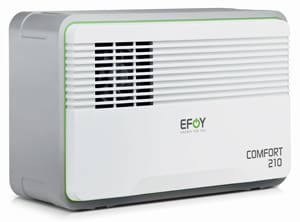When it comes to alternative power (i.e., not diesel or gasoline), for a long time the choices have been solar, wind or water power. There is another option that’s fossil free: hydrogen-powered fuel cells. Until recently, however, this was more of a blue-sky promise than a viable product. You had to be a chemist and industrial engineer to put together a fuel cell system for your boat — there wasn’t an easy-to-use, off-the-shelf product that could do it. Actually, an easy-to-install and largely automatic product has been around a few years now. It’s called Efoy Comfort (www.efoy-comfort.com) and it’s one of the best examples yet of a plug-and-play fuel cell.
Fuel cells are intriguing in much the way solar panels seem almost magical: They produce electricity without any moving parts. Other than solar panels, of course, most methods for generating electricity require a permanent or electromagnet to be moving in relation to a coil of wire. That mechanical motion can introduce wear, vibration, noise and the potential for mechanical failure.
A simplified way of thinking about how a fuel cell works is that it makes use of hydrogen wanting to combine with oxygen and make water (there’s something poetic in there for voyagers who are also in love with water). Hydrogen atoms are induced to give up their electrons, which are used on the boat and then returned to the cathode side of the fuel cell where they combine with positive hydrogen ions and oxygen to produce water and some carbon dioxide. These chemical reactions and the DC electricity they produce will continue indefinitely as long as a supply of hydrogen and oxygen is available. And with no moving parts, the process is inherently a quiet one.
The process takes place in a structure called a cell, which is comprised of an anode plate and a cathode plate on ether side of a permeable membrane that acts as an electrolyte and holds a catalyst. When the hydrogen atoms hit the catalyst, they release their electrons and become positively charged ions. The membrane allows these hydrogen ions to flow from the anode to the cathode but blocks the electrons, which must travel out of the cell and through the boat’s DC circuits before returning to the cell at the cathode. Any one cell in a fuel cell unit is limited to a little less than a volt, so to get higher voltages the cells are “stacked” like chocolate wafers in an icebox cake.
 |
|
Mini-Transat racer Charlie Dalin uses the Efoy Comfort on his race boat. |
|
Courtesy Efoy |
Getting the oxygen for use in a fuel cell is easy — just let air flow through it. What about the hydrogen, though? Taking along a tank of hydrogen gas doesn’t seem too practical on a voyaging sailboat, where space is at a premium — not to mention the danger of leaks with highly inflammable hydrogen. The Efoy Comfort unit avoids this problem by using methanol. Methanol (wood alcohol, CH3OH) is a compound of carbon, oxygen and hydrogen. The hydrogen is used and the carbon and oxygen combine to form CO2 that is vented from the unit. You can buy methanol for your unit from Efoy. It supplies the methanol in containers it calls cartridges. North American users can purchase 18.5-pound, 2.64-gallon M10 fuel cartridges that Efoy says have a nominal capacity of 11.1 kilowatt-hours. According to Efoy, assuming an average requirement of 33 amp-hours/day (400 Watt-hours/day), one M10 will last approximately four weeks of use.
The unit also produces some water as a result of the chemical reaction that produces electricity, but the water is not potable and can’t be consumed.
While Efoy Comfort hasn’t made a big splash in North America, the German-designed and built fuel cell generator has been available in Europe for some time and Efoy has many testimonials from European users. Volker Andreae of the German Offshore Owners Association wrote this: “This summer we used an EFOY 1600 ourselves, for long-distance races like Gothenburg Offshore in the Skagerrak or our summer tour in the West-Swedish Skerries. Clearly said: We are thrilled with the performance! This fuel cell delivers a charging current of 5.4 amperes with 12 volts; so around 65 Watts or 1600 Watt-hours a day. Perhaps 65 Watts are not sufficient to supply the complete requirement for the bigger yachts with their numerous consumers. However, here help can be found with the parallel connection of another cell or occasional conventional reloading. For more economical energy consumers like ourselves, an EFOY 1600 is sufficient for round-the-clock energy.”
The Efoy Comfort product comes in three sizes: the $3,499 model 80, which is rated for 80 amp-hours a day; the $4,999 140 at 140 Ah/day and the $6,999 210 at 210 Ah/day.

